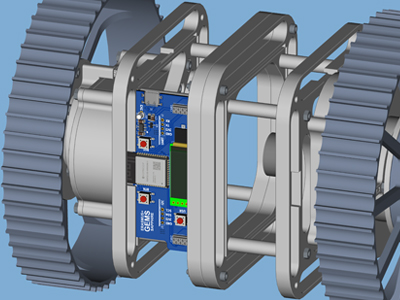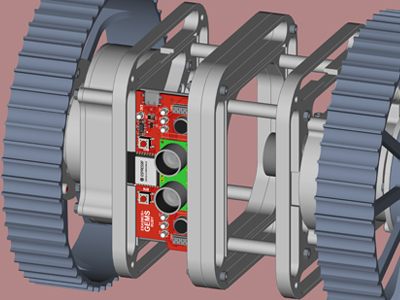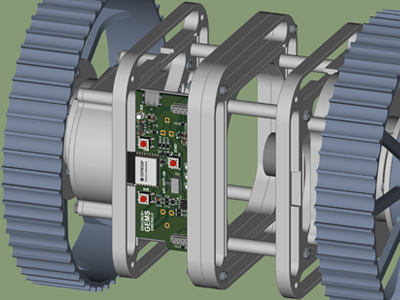Overview
Learn the fundamentals of electrical drives, including hardware and control systems, and how to implement and control a DC drive in robotic applications.
Mechatronic systems are transforming our world, with robots as some of the most impactful examples. These versatile machines enhance efficiency across diverse fields, from manufacturing and agriculture to household tasks and space exploration.
At the heart of robotics, electrical drives enable controlled motion, forming the backbone of these systems.
This course equips you with the fundamental knowledge to implement the hardware and control loop of an electrical drive in mechatronic systems. It will be your gateway to implementing electrical drives in robotics.
Who is this course for?
Designed for engineering students and young engineers with little or no experience in electrical drives, this course is also ideal for experienced professionals looking to expand or refresh their expertise. Through hands-on learning with practical examples and simulation models, you will develop the skills to model, simulate, implement, and test an electrical drive.
A hands-on approach: build your own robot
One of the course's unique features is its use of modular mechatronic educational hardware. This hardware facilitates a systematic approach to designing robotic applications, guiding you through the entire process of mechatronic system integration – from conceptualization and analysis to construction and control.
The open-source hardware and firmware enables customization, making it adaptable for various applications, including student thesis projects. Additionally, the course integrates knowledge of other robotics components, such as sensing, communication, and system integration, highlighting their role in electrical drives.
Full Program
This course is an initiative of the Erasmus + project GEMS (Graceful Equalizing of Mechatronics Students). It is part of the online program Building Robots: From Mechatronic Components to Robotics, developed by GEMS partners, with Delft University of Technology leading the part about robotics through motion control.
What You'll Learn
- Understand how electrical drives play a role in robotics
- Explain the system and control architecture of an electrical drive
- Describe how power, sensing and control components work together in an electrical drive
- Model and simulate a DC-motor-based electrical drive
- Tune the control loop of an electrical drive
- Experience the implementation of a practical DC drive
After taking this course, you will be able to:
- Make critical design choices for a practical electrical drive within given specifications
- Model an electrical drive as a component for system integration in robotics
- Work with other disciplines to develop motion control using electrical drives
- Deploy motor drive hardware and implement the control loop
Details
Course Syllabus
Week 1: Motors and actuators in robotics
- Explain the role of motors and drives in robotics
- Describe the operating principles of various motors and actuators
Participants learn the roles and basic principles
Week 2: DC motor: structure principles and performance
- Explain the structure and operation principles of DC machines
- Draw the equivalent circuit of a DC machine
- Calculate the DC machine performance based on equivalent circuit
- Model the dynamics of a DC machine.
Participants will learn how a DC machine is modeled mathematically and how to calculate and simulate it.
Week 3: Power converters: components, topology and modulation
- Explain the various types of semiconductors
- Describe the half-bridge as a basic building block of power converters
- Describe the pulse-width modulation principle
- Calculate the voltage output from duty cycles
Participants will learn how to implement, modulate, calculate and simulate a power converter.
Week 4: DC electrical drive: closed-control system architecture
- Describe the hardware architecture of a DC drive
- Explain various feedback sensors involved in DC drives
- Draw the control block diagram of a DC drive
Participants will learn how the hardware to enable closed-loop control is implemented and to simulate an open-loop DC drive system.
Week 5: Closed-loop controller design of DC electrical drives
- Describe the dynamics of DC electrical drive systems
- Explain how PI controllers can be used for closed-loop control
- Tune PI controller parameters based on transfer functions
- Explain how a discrete PI controller is implemented
Participants will learn how to construct and tune the closed-loop controller and simulate a closed-loop DC drive system.
Week 6: Implementation of closed-loop control of DC drives
- Implement a closed-loop DC drive from given components
- Tune the control loop empirically in a stepwise manner
Project: realize closed-loop speed tracking and position tracking with given hardware and control algorithms
Qualifications
Chartered Engineering Competences
All our online courses and programs have been matched to the competences determined by KIVI’s Competence Structure, a common frame of reference for everyone, across all disciplines, levels and roles.
These competences apply to this course:
- A1: Extend your theoretical knowledge of new and advancing technologies.
- B2: Conduct appropriate research, and undertake design and development of new and creative engineering solutions.
Admission
This is a Massive Open Online Course (MOOC) that runs on edX.
Prerequisites
- Knowledge of linear circuits
- Basic electronics and control
- Experience in microcontroller programming


